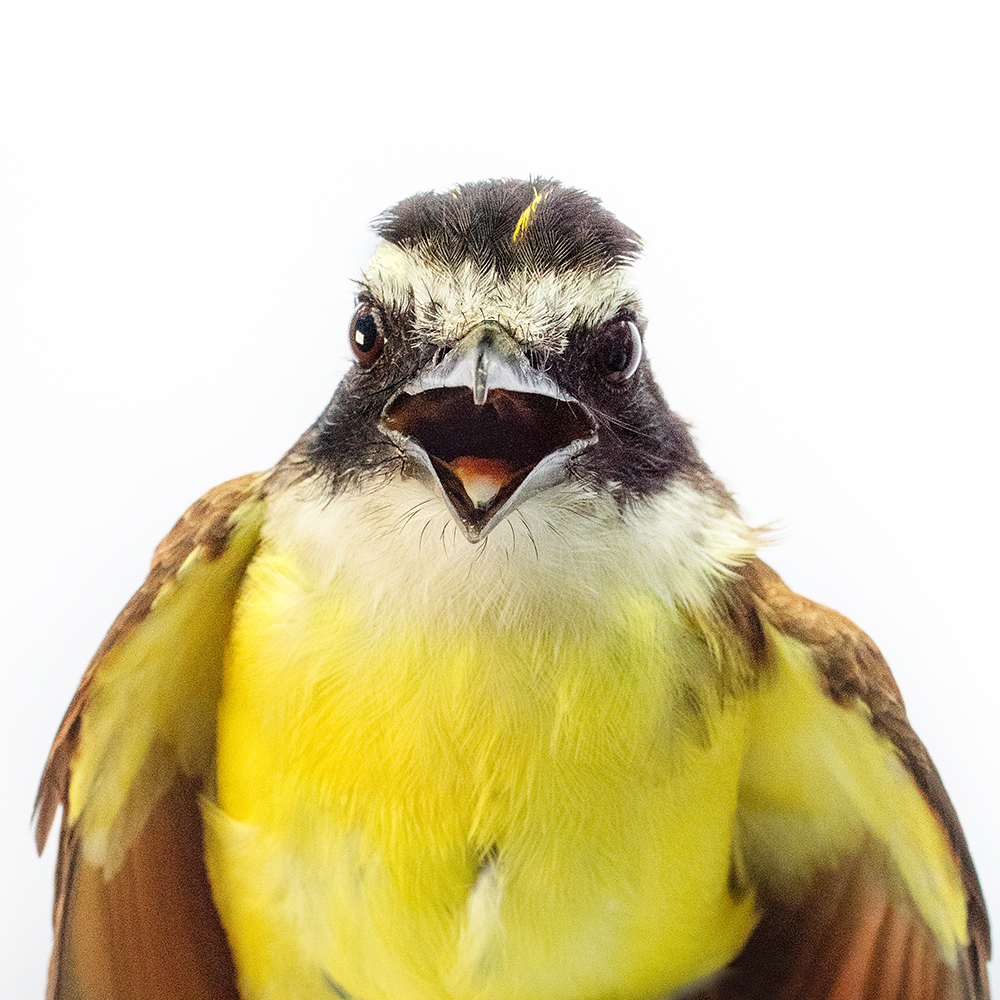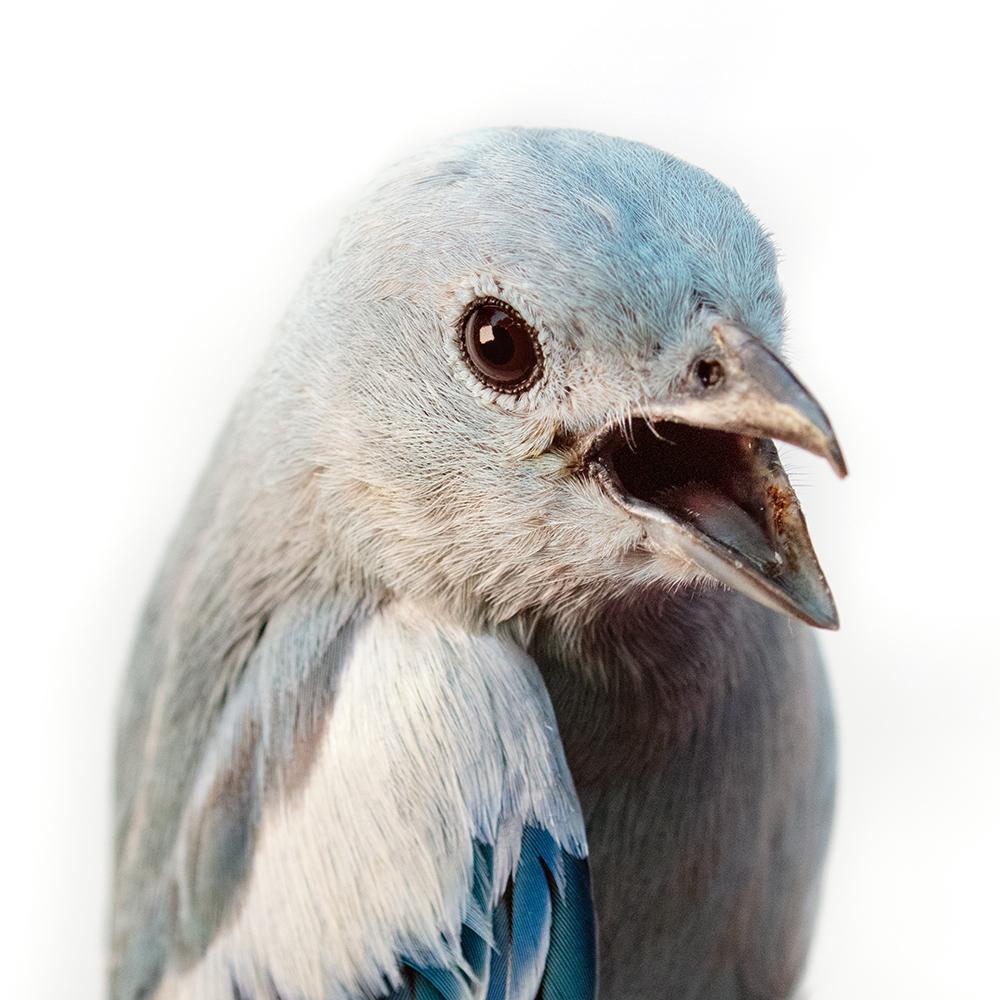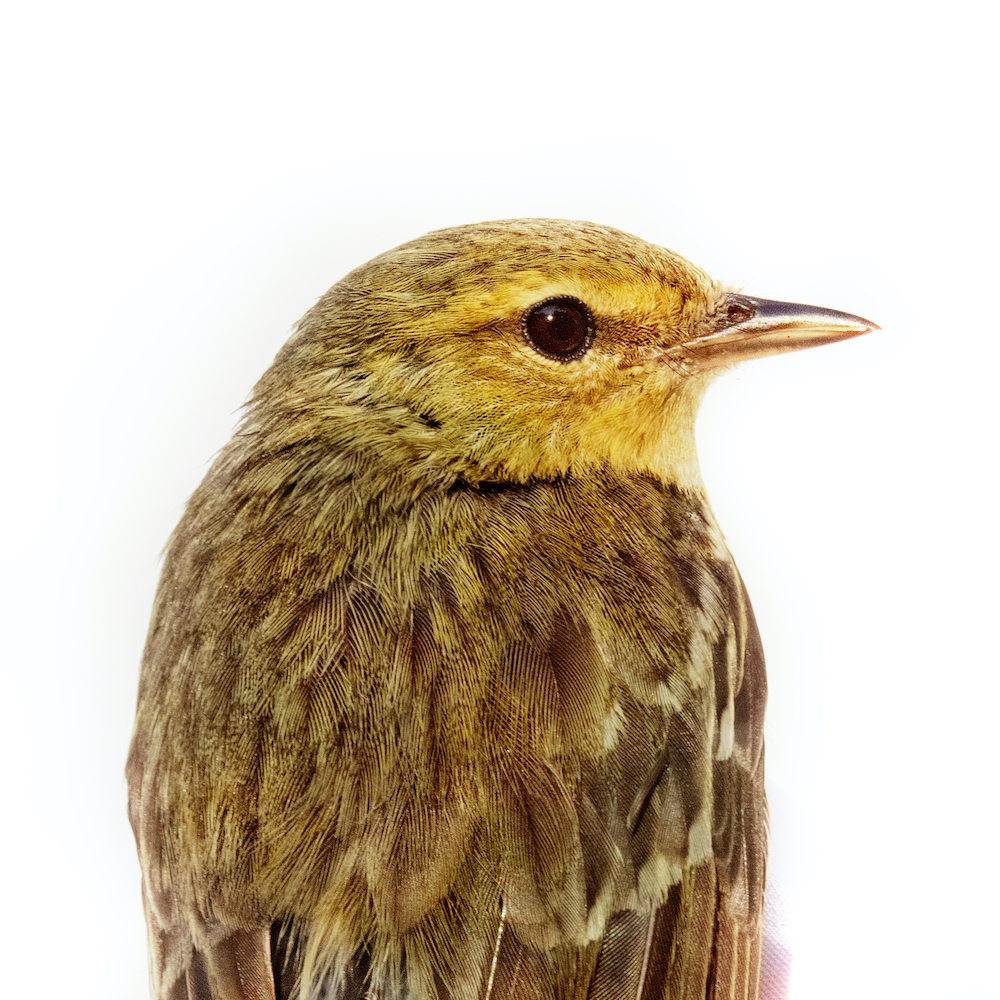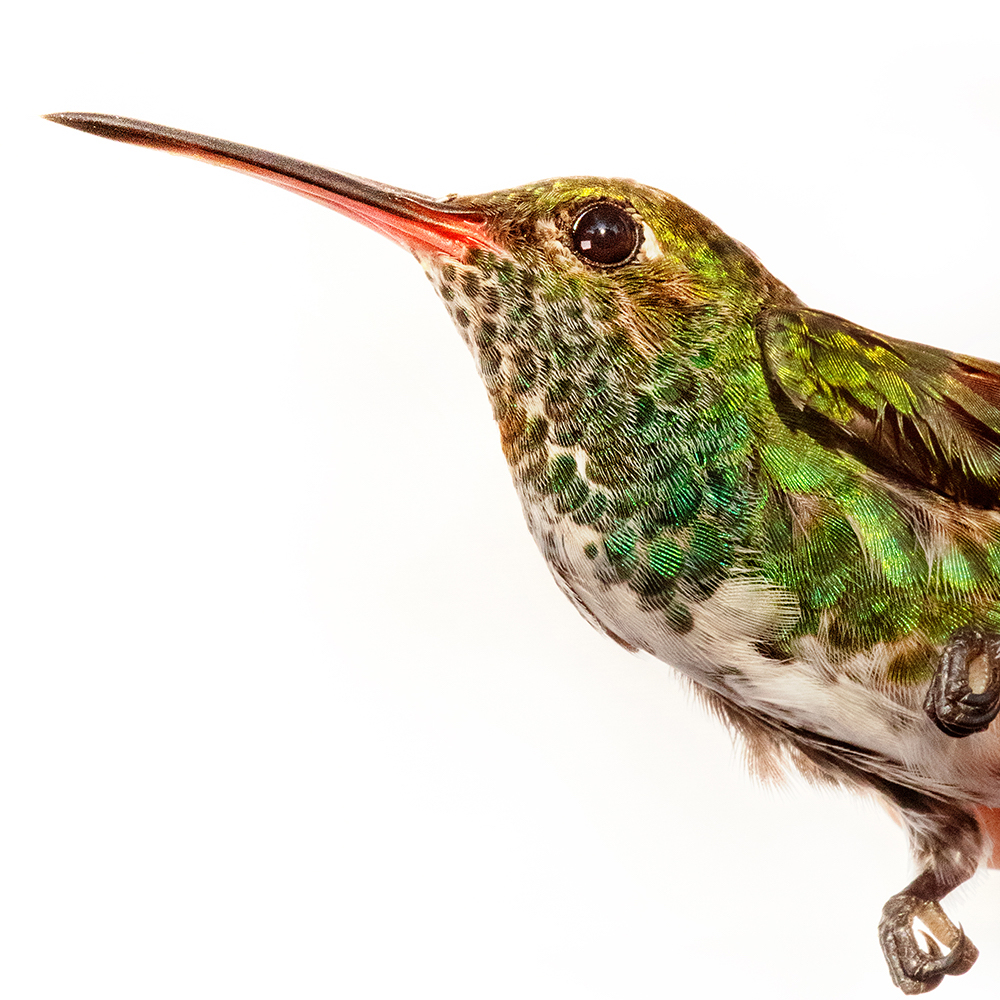
Bill DeLuca canÔÇÖt quite believe his eyes. The ╠¢╗¿¥½Ðí migration ecologist has spent years studying Blackpoll Warblers on their breeding grounds in remote boreal forests in the United States and Canada. On this morning in late winter 2020, heÔÇÖs standing in an orange grove in Villavicencio, Colombia, where the Andes Mountains meet the vast Llanos savanna and cattle ranches abound. HeÔÇÖd always pictured Blackpolls overwintering in towering old-growth tropical forests, not in the low canopy of neatly ordered citrus trees. But a sharp chip tells him there are indeed Blackpolls in this manicured landscape. ÔÇ£This is weird,ÔÇØ he says. ÔÇ£So weird.ÔÇØ
Yet the greenish-yellow warblers seem right at home, hunting for insects amid the bustling locals. Blue-gray Tanagers, Russet-throated Puffbirds, and Bananaquits inhabit the low canopy, while Bare-faced Ibis forage along the ground like cattle grazing in a pasture. Crested Caracaras perch on fenceposts along the dirt road, and Wood Storks, Whistling Herons, and White-throated Toucans frequent the adjacent irrigation channel.








Hover over each image to see the name of Blackpoll's neighbors in Villavicencio. Photos: Mike Fernandez/╠¢╗¿¥½Ðí
Blackpolls may look unremarkable compared to their neighbors here, but as DeLuca knows better than most, theyÔÇÖre worthy of superlatives. In spring males undergo a dramatic costume change, swapping out drab, nonbreeding plumage for striking black and white feathers, complete with the distinctive black crown for which the species is named. Blackpolls migrate farther than any North American warbler, some clocking . Even more impressive: Their overwater journey is among the longest of any songbirdÔÇÖs, with some individuals flying in a three-day nonstop push south over the Atlantic Ocean during hurricane season.
Blackpolls have only recently started to give up long-held secrets. Just seven years ago DeLuca and a team of international colleagues proved the birds make this dangerous oceanic trek by attaching tiny trackers called geolocators to Blackpolls on their boreal breeding grounds. Now, DeLuca is tagging the birds where they overwinter. HeÔÇÖs aided by Colombian scientists Andrea Morales Rozo, Maira Holguin, and Nahbi Romero Rodriguez, who know itÔÇÖs far easier to catch Blackpolls in these orchards than in the dense Amazon rainforest, where most of the species disperses. In six days of mist netting theyÔÇÖll affix the dime-size sensors to 23 Blackpolls. The data they recover from any recaptured the following spring will help fill in more pieces of the puzzle of Blackpoll movements.
That information will be a valuable addition to ╠¢╗¿¥½ÐíÔÇÖs Migratory Bird Initiative, a program that aims to create a more comprehensive and holistic picture of avian migration in the Western Hemisphere. Since 2018 ╠¢╗¿¥½Ðí scientists have been compiling records contributed by more than 100 researchers and institutions, including long-term data from Cornell Lab of OrnithologyÔÇÖs eBird and the USGS Bird Banding Laboratory, into a single resource that reflects the movements of thousands of individual birds and more than 450 species. This year MBI will unveil its centerpiece: an interactive online platform, called the Bird Migration Explorer, with visualizations of each of the speciesÔÇÖ journeys and the risks they encounter throughout the year. ÔÇ£The vision is to secure the future of migratory birds in the Western Hemisphere by identifying the places that they need across the Americas,ÔÇØ says MBI senior director Jill Deppe.
Time is of the essence. An estimated 3 billion birds have disappeared in North America since the 1970s, according to a study published in the journal Science in 2019. Migrants have been especially hard hit. Their survival demands flying long distances twice a year, a perilous undertaking made even riskier by extreme weather events, building collisions, predation by cats, and habitat loss. To prevent losing billions more, we need a more complete understanding of birdsÔÇÖ movements and how populations fit together, says Peter Marra, director of and founder of the , both MBI partners. ÔÇ£We needed to do this 20 years ago, but there were technological limitations,ÔÇØ Marra says. ÔÇ£Now weÔÇÖre in a renaissance of ornithology because new technologies are allowing us to track birds 24/7.ÔÇØ
If the Migratory Bird Initiative had a mascot, it might well be the Blackpoll Warbler. The far-flung traveler, which has experienced steep declines in recent decades, connects vastly different ecosystems: boreal forest, open ocean, Amazon rainforest, and everywhere in between. WhatÔÇÖs more, data from tracking birds on the move combined with on-the-ground monitoring at hotspots promise to help pinpoint where Blackpolls are running into trouble, paving the way to address threats. ThatÔÇÖs no easy feat for such a wide-ranging species, but itÔÇÖs finally within reach thanks to a new era of migration science.
Twice a year every year, billions of birds representing about two-fifths of the worldÔÇÖs avian species migrate. Their journeys are as short as a ClarkÔÇÖs NutcrackerÔÇÖs jaunt, a few thousand feet down and up a mountain slope, and as long as an Arctic TernÔÇÖs 25,000-mile trek from the Arctic to the Antarctic and back. No one knows how old the phenomenon is, though thereÔÇÖs evidence it dates back more than 100,000 years. Genetic sleuthing revealed the Gala╠üpagos Hawk, endemic to the islands 600 miles off South America, is an evolutionary offshoot of the SwainsonÔÇÖs Hawk; itÔÇÖs thought that between 125,000 and 250,000 years ago a flock of SwainsonÔÇÖs migrating between North and South America veered off course, landed in the Gala╠üpagos, and became the founding population of a new species.
Why birds began migrating is another unknown. A leading theory posits that migration evolved gradually. Some individuals ventured short distances in search of less competitive food or breeding conditions. Those that successfully exploited resources elsewhere survived and passed along migratory behavior to their offspring. As climatic conditions changed and ice sheets retreated, migrants extended their seasonal boundaries more and more. Their offspring inherited the urge to travel, switched on by hormones triggered by day-length changes and timed to track the northerly ÔÇ£green waveÔÇØ of spring growth and the emergence of energy-rich insects.
Humans have been aware of birdsÔÇÖ seasonal shifts for millennia, but only in the past century have we been able to figure out where individual birds go, how they get there, and whether they return. Hans Christian Cornelius Mortensen laid the groundwork for migration science when he attached aluminum leg rings to European Starlings in 1899. Now a mainstay of ornithological research, banding stations reveal long-term trends in the numbers of migrants moving through a specific area. In the past two decades, scientists have used feathers, blood, and fecal samples collected while birds are in hand for isotopic and genetic analyses that tell where in the world a bird has been foraging and which breeding population it belongs to.
The technology to track birds on the wing emerged in the early 1960s when scientists in Minnesota detected, via a stationary antenna, radio signals from a transmitter attached to a Mallard flying past. Every decade since then the technology has evolved, enabling scientists to follow birdsÔÇÖ movements over longer distances and expanding the number of species they were able to study. In the early days researchers attached receivers and antennae to vehicles and planes to chase tagged birds a few hundred miles as they flew. They were able to take a more hands-off approach beginning in 1984 with the emergence of tags that transmitted a signal to the ARGOS satellite network.
At first only larger birds, like Bald Eagles, Trumpeter Swans, and Wandering Albatrosses, could be tracked. Because tags shouldnÔÇÖt exceed 3 to 5 percent of an animalÔÇÖs body weight, much smaller birds, such as Purple Martins and Arctic Terns, had to wait for the advent of much smaller devices. The past two decades brought about geolocators, half-gram sensors that record light intensity to glean location estimates, and even tinier nanotags that emit radio signalsÔÇöalong with the Motus Wildlife Tracking System, which revolutionized radio telemetry with automation. Most recently, Icarus came online in 2020. That initiative uses the International Space Station to receive data from the lightest GPS tags yet, adding to the bevy of options scientists have today.
Each technology has trade-offs, says Stu Mackenzie, director of strategic assets at the nonprofit , an MBI partner. Satellite tags, for example, are the most geographically accurate, but theyÔÇÖre also relatively heavy and expensive. ÔÇ£The technologies arenÔÇÖt competitive; theyÔÇÖre all complementary,ÔÇØ Mackenzie says. With so many options, the sheer number of birds being tracked has exploded in recent years: ÔÇ£WeÔÇÖre in a different realm of migratory bird research and conservation.ÔÇØ
Geolocators have shown, for instance, that Atlantic Puffins overwinter in the Atlantic Ocean above a network of undersea mountains and caves where their prey fish abound. The discovery in part led President Obama to create the Northeast Canyons and Seamounts Marine National Monument in 2016 to provide refuge from overfishing, pollution, and ship traffic. And nanotags affixed to Black Tern fledglings in 2020 in Michigan, where the population has experienced a 70 percent decline in the past 50 years, revealed that the birds successfully make it out of the Great Lakes region in the fall. This hints that they may be most at risk when migrating to or overwintering along Central and South American coasts.
While technology is key to unlocking these mysteries, obtaining the data that the Migratory Bird Initiative depends upon still requires old-fashioned fieldwork. After all, bands and tags donÔÇÖt attach themselves.
The Blackpoll Warblers that DeLuca and his colleagues tagged in Colombia are a small part of a larger tracking project that has mostly focused on birds on their North American breeding grounds. The key toÔÇöand challenge ofÔÇögeolocators is collecting them after a full migration cycle. For 12 months the gadgets record a birdÔÇÖs location. Scientists must then recapture the bird to access that data. Blackpolls spend a scant three months breeding and rearing chicks across a huge swath of the upper reaches of the continent, and the chances of capturing them there are best in early summer, when territorial tenacity is at its peak.
In June 2020 researchers fanned out across the boreal to recover geolocators theyÔÇÖd deployed on nearly 100 Blackpolls the previous summer. One crew led by Hilary Cooke from camped out by a remote lake in northern British Columbia for two weeks, enduring clouds of mosquitos as the team anxiously scanned the trees for birds sporting telltale colored leg bands. ÔÇ£ItÔÇÖs agonizing because youÔÇÖre waiting for 12 months before you even know whether the birds come back,ÔÇØ she says. Two thousand miles east, Bruno Drolet and Junior Tremblay of , the nationÔÇÖs environmental department, awoke at 2 a.m. every day to drive to a field site an hour from Quebec City and open the nets 30 minutes before dawn. Because some Blackpolls alighted high up in black spruce trees more than a dozen feet tall, the team had to double the height of their nets and use a ladder to remove their temporary captives. Even farther to the east, a third crew of academic, nonprofit, and federal scientists revisited a black spruce forest in Newfoundland. In all, the teams recovered 17 geolocators.
The results, which are still being analyzed, will add to the collective knowledge of the effort, which began soon after geolocators hit the market in 2012. When Ryan Norris, an ecologist at the in Ontario, first heard about the tiny sensors, he ordered some immediately, hoping to solve the mystery of the birdsÔÇÖ fall migration route: ÔÇ£My first thought was Blackpolls, because there was all this indirect evidence that they were flying over the Atlantic.ÔÇØ He quickly found he wasnÔÇÖt the only oneÔÇöMackenzie, Marra, DeLuca, and others had the same idea. ÔÇ£We decided, well, if weÔÇÖre doing this, we might as well team up and do it together.ÔÇØ
In 2013 collaborators tagged 37 birds in and Nova Scotia. The data stored on the five geolocators they recovered in 2014 proved Blackpolls do indeed make the treacherous trans-Atlantic flight in the fall and, in a clockwise elliptical migration, return overland up the Eastern Seaboard in the spring.
Curious about the trajectories of western-breeding birds, in 2016 collaborators tagged 111 individuals in Nome, Alaska; Denali National Park; the Yukon; and Churchill, Manitoba. The 27 tags recovered in 2017 revealed that as days shorten in August, a wave of Blackpolls, starting with the westernmost breeders, moves southeast across Canada to the Atlantic Coast. There they gather alongside eastern breeders for about three weeks, gorging on insects and berries and almost doubling their weight, the slim 12-gram birds ballooning into puffballs. They depart when weather conditions are favorable, often when a cold front arrives in October, catching the winds at sunset and riding them south. They stop over in the Caribbean or the tip of South America before settling in northern South America, where it appears Blackpolls from various breeding populations overlap. Come spring, the Alaska breeders that make the longest trips leave first.
By tagging Blackpolls across their range, and on both their breeding and overwintering grounds, scientists are obtaining a more holistic picture of the various Blackpoll populations and how they move and intermix. Experts suspect Blackpolls, though still numerous, have declined in population since 1970. ÔÇ£ItÔÇÖs important that we share the data so we can better understand the status of the species overall and the different populations,ÔÇØ Tremblay says.
Bringing together siloed troves of data for migratory species is core to MBIÔÇÖs mission and intrinsic to its success. While thousands of birds from hundreds of species have been tracked in the Western Hemisphere, the data tracing their journeys live in different databases and on different laptops in multiple countries. To access the records, MBI scientists have spent years building trust among stakeholders. At the urging of these groups, ╠¢╗¿¥½Ðí has solicited input from scientists and conservation organizations throughout the Bird Migration ExplorerÔÇÖs development. The platform and resulting publications will acknowledge the contributions of all the scientists who collected the data.
ÔÇ£The fact that ╠¢╗¿¥½Ðí has wanted help and feedback has been important for ensuring that the initiative makes the largest impact possible in bird conservation,ÔÇØ says Autumn-Lynn Harrison, one of dozens of experts who have lent their expertise to MBI. SheÔÇÖs the program manager of the Migratory Connectivity Project, which, with research partners across the Americas, has launched field studies focused on 25 species that are either understudied or of conservation concern since 2014. Next year the group plans to publish of migratory connectivity for 540 North American bird species.
Harrison says MBIÔÇÖs public-facing platform fills a unique niche. With it, anyone will be able to explore the annual movements of hundreds of migratory species and see how the birds that move through their backyard spread out across the hemisphere. ÔÇ£ItÔÇÖs going to allow the public to share the joy and excitement of discovery that scientists are experiencing all the time,ÔÇØ she says. ÔÇ£By working together as a conservation community, we can reach as many audiences as possible, in as many media as possible, to inspire people to take action to save birds.ÔÇØ This unprecedented view into migration is poised not only to capture peopleÔÇÖs imaginations, but also to be a powerful tool for conservationÔÇöone that can inform and guide actions to protect birds now.
In mid-2020 the New York Attorney GeneralÔÇÖs Office contacted . Letitia James was considering joining other attorneys general in challenging the Trump administrationÔÇÖs decision to open the Arctic National Wildlife Refuge coastal plain to oil and gas drilling. The complaint argued in part that the refuge was created explicitly for conservation purposes, and development would irreparably damage habitat on which birds that migrate through all 50 states depend. Was there scientific evidence, JamesÔÇÖs staff queried, connecting birds in New York to the Arctic Refuge that would justify joining the lawsuit?
In the past, answering that question would have required an extensive search through databases that hold decadesÔÇÖ worth of dense scientific papers. Instead, ╠¢╗¿¥½Ðí New York reached out to the MBI team, which had the evidence at its fingertips. MBIÔÇÖs custom mapping showed how Semipalmated Sandpipers, American Golden-Plovers, Tundra Swans, and other birds moved between the Empire State and the Arctic Refuge. The New York office joined the suit. Though the U.S. Department of the Interior issued nine leases in President TrumpÔÇÖs final days in office, last June the Biden administration put them on hold, citing legal flaws in the previous administrationÔÇÖs environmental analysis.
So far MBI contributors have shared tracking information for 134 species. Turning the mountains of disparate data into searchable maps is no small feat. A single Semipalmated Sandpiper tagged with a geolocator might produce more than 700 records related to its location in the gadgetÔÇÖs 12-month lifespan. A satellite-tagged Bar-tailed Godwit might generate thousands over a couple of years before the device falls off. Many tags also record environmental parameters, such as temperature and moisture, and have motion sensors that reveal whether a bird in flight is gliding or flapping its wingsÔÇöinfo used to extrapolate the energy it requires to travel a given distance.

ON TRACK
Geolocators attached to Blackpoll Warblers on their breeding grounds
show that, in fall, birds gather on the East Coast and then ´¼éy nonstop
south over the open ocean. Inset: A Blackpoll tagged on her wintering
grounds in 2020 shows northbound birds prefer an overland route with
ample opportunities to refuel.
Nome
Denali
Churchill
Whitehorse
CANADA
Hudson
Vermont
Bay
Nova
arrived
UNITED
Scotia
June 11-15
CANADA
STATES
June 9
UNITED
Atlantic
STATES
June 7
Ocean
June 4
June 3
June 2
SOUTH
Villavicencio
AMERICA
left May 5

ON TRACK
Geolocators attached to Blackpoll Warblers on their breeding grounds show that, in fall, birds gather on the East Coast and then fly nonstop south over the open ocean. Inset: A Blackpoll tagged on her wintering grounds in 2020 shows northbound birds prefer an overland route with ample opportunities to refuel.
Nome
Denali
Churchill
Whitehorse
CANADA
Hudson
Vermont
Bay
Nova
arrived
UNITED
Scotia
June 11-15
CANADA
STATES
June 9
UNITED
Atlantic
STATES
June 7
Ocean
June 4
June 3
June 2
SOUTH
Villavicencio
AMERICA
left May 5
The nonprofit , hosted by the Max Planck Institute of Animal Behavior, provided an elegant solution to this mind-boggling data problem. All MBI contributors were asked to upload the information to MovebankÔÇÖs online platform, which helps researchers manage, share, analyze, and archive animal-movement data. ÔÇ£That way, the data are harmonized, and no one has to deal with 70,000 different data files in different formats,ÔÇØ says Sarah Davidson, Movebank data curator.
The Bird Migration Explorer will feature visualizations of the journeys taken by 450 migratory species. Maps for the 134 species with tracking data will show the precise pathways of individual tagged birds, while all the maps will depict the broad movement of species based on actual bird sightings and banding records. These movements rely heavily on the ÔÇÖs analyses of data from ; the lab applied advanced statistical models to hundreds of millions of bird sightings to reveal avian abundance patterns across the hemisphere through each season. data from the more than 77 million birds in North America banded since 1923 further bolster the visualizations, as does genetic connectivity information from the .
Maps of routes alone wonÔÇÖt help us protect migratory birds, says Deppe. You also have to know where they face the highest riskÔÇötoday and in the future. So MBI scientists incorporated into the Explorer the challenges each species encounters. As a user follows a birdÔÇÖs journey, they see where existing threatsÔÇöfrom logging and light pollution to drought and floodingÔÇöcrop up. And just as they did with the request from the New York Attorney GeneralÔÇÖs office, Deppe envisions her team providing custom analyses for policymakers and conservation managers about the potential impact of proposed mines, wind farms, or other development projects on migrants.
ÔÇ£WeÔÇÖre living in the sixth mass extinction,ÔÇØ Marra says. ÔÇ£We need to be more quantitative and more strategic in how we start addressing threats.ÔÇØ ThatÔÇÖs what the Migratory Bird Initiative ultimately aims to do: By pulling the movements of migrants into a single platform, along with threats, the initiative is revealing which sites are most essential during migration, and thus need safeguarding to protect the most birds.
In February 2021 Scientists from the Colombian nonprofit returned to the same orange groves that had befuddled DeLucaÔÇÖs senses the previous year. Angela Caguazango and Maira Holguin spotted two tagged Blackpoll Warblers. One eluded them, but they caught the other.
The geolocator allowed them to retrace the female birdÔÇÖs journey over the past year. She spent March and April in the vicinity of the grove. The first week of May, she flew north to Venezuela and landed near the coast, then made a multi-week excursion inland to the forests of a national park in central Venezuela. She returned to the coast a couple of days before leaving South America around June 2. The reason for the jaunt to the woods? ÔÇ£ItÔÇÖs all about the food,ÔÇØ says DeLuca, surmising the protected area has plentiful insects.
A day or two later she landed in Cuba, then hit Florida the next day. A week later, after winging over the D.C. area and the Great Lakes, she arrived at her breeding grounds east of Hudson Bay in northeastern Canada, a place DeLuca notes is a Blackpoll hotspot. The geolocator died while the bird was there, but in all likelihood, four months later, she made a stopover on the East Coast and barreled down to South America.
Until recently, where Blackpolls make landfall in South America and what they do once they arrive were largely unknown. Biologists surveying the countryÔÇÖs Caribbean coast stumbled into one answer in October 2016, when they found roughly 1,000 Blackpolls in thorny scrub on the arid Guajira peninsulaÔÇöa mere 20 miles from Sierra Nevada de Santa MartaÔÇÖs humid forests, where most other migrants land. ÔÇ£It was completely unexpected,ÔÇØ says Nick Bayly, SelvaÔÇÖs director of migration ecology research and an MBI contributor.
The following two Octobers, Bayly and colleagues banded more than 1,200 Blackpolls at the site. The birdsÔÇÖ physical state was shocking, he says. Twenty percent were emaciated from their journeys, some weighing little more than 8 gramsÔÇötwo-fifths of their pre-migration weight. Why, they wondered, were Blackpolls landing in this seemingly inhospitable spot?
To echo DeLuca: food. The birdsÔÇÖ arrival coincides with peak rainy season, when hordes of caterpillars emerge and devour young leaves, the scientists last year in the journal Ornithology. In as few as three days Blackpolls put on as much as two grams, enough to fuel their final push 300 miles or more to overwintering grounds. Other migrants caught in the nets, including Connecticut Warblers and Yellow-billed Cuckoos, also arrived in time for the brief buffet.
This newly discovered refueling site is threatened by banana plantations and coal mines. Now that Selva knows its value to migrants, it is partnering with local nonprofit to increase native trees on the peninsula. TheyÔÇÖve established a nursery and planted nearly 10,000 trees so far, providing more of a safety net for exhausted migrants, like the female Blackpoll Caguazango and Holguin recaptured.
Assuming she survived the migratory gauntlet for another year, right now she could be foraging in the orange trees where she was first tagged. SheÔÇÖs mere days from following the innate urge to head north, propelled to continue her annual circular journey across the hemisphereÔÇöa journey that has long sustained her species, and that, if weÔÇÖre willing to help, will continue for untold generations to come.
This story originally ran in the Spring 2022 issue as ÔÇ£Have Wings, Will Travel.ÔÇØÔÇï To receive our print magazine, become a member by .

